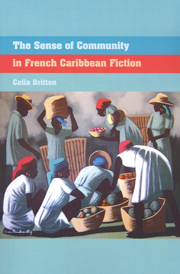Book contents
- Frontmatter
- Contents
- Acknowledgements
- Abbreviations
- Introduction
- 1 Restoring Lost Unity in Jacques Roumain's Gouverneurs de la rosée
- 2 Past, Future and the Maroon Community in Edouard Glissant's Le Quatrième Siècle
- 3 Living by Mistake: Individual and Community in Simone Schwarz-Bart's Pluie et vent sur Télumée Miracle
- 4 Singular Beings and Political Disorganization in Vincent Placoly's L'Eau-de-mort guildive
- 5 Conquering the Town: Stories and Myth in Patrick Chamoiseau's Texaco
- 6 Community, Nature and Solitude in Daniel Maximin's L'Ile et une nuit
- 7 On Not Belonging: Surrogate Families and Marginalized Communities in Maryse Condé's Desirada
- Conclusion
- Notes
- Bibliography
- Index
2 - Past, Future and the Maroon Community in Edouard Glissant's Le Quatrième Siècle
- Frontmatter
- Contents
- Acknowledgements
- Abbreviations
- Introduction
- 1 Restoring Lost Unity in Jacques Roumain's Gouverneurs de la rosée
- 2 Past, Future and the Maroon Community in Edouard Glissant's Le Quatrième Siècle
- 3 Living by Mistake: Individual and Community in Simone Schwarz-Bart's Pluie et vent sur Télumée Miracle
- 4 Singular Beings and Political Disorganization in Vincent Placoly's L'Eau-de-mort guildive
- 5 Conquering the Town: Stories and Myth in Patrick Chamoiseau's Texaco
- 6 Community, Nature and Solitude in Daniel Maximin's L'Ile et une nuit
- 7 On Not Belonging: Surrogate Families and Marginalized Communities in Maryse Condé's Desirada
- Conclusion
- Notes
- Bibliography
- Index
Summary
Edouard Glissant differs from the other writers considered in this book in that he is known as a philosopher as well as for his novels and poetry. The concepts of ‘Relation’ and ‘opacity’ that he develops in the essays collected in Poétique de la Relation in 1990 resonate closely with Nancy's reworking, over approximately the same period of time, of the notion of community. Nancy has written on mixed or creolized cultures in terms that are not unlike Glissant's treatment of this theme. But his more general concept of ‘being-singular-plural’ also has striking similarities with Glissant's ‘Relation’. In the first place, both insist on the primacy of the plural: the collective dimension of being is not something added on to an originary individual subject, but is itself originary. Like Nancy's singular beings, the component elements of Relation have no independent existence outside it: ‘La Relation, nous l'avons souligné, ne joue pas sur des éléments premiers, séparables ou réductibles […] Elle ne se précède pas dans son acte, ne se suppose aucun a priori’ (Poétique, p. 186). But at the same time, both writers refuse to conceive of this ‘primordial plurality’ (BSP, p. 67) as a fusion based on closure and sameness. ‘Relation’ theorizes the relation, precisely, of different elements: ‘non pas des indistinctions amalgamées, mais des écarts déterminants’ (Poétique, p. 157); and Glissant projects a new literature ‘par où le communautaire, sans s'effacer […] initierait à la totalité sans abdiquer le particulier; et relativiserait de la sorte le spécifique sans avoir à confondre l'Autre […] dans une transparence réductrice’ (pp. 67–68).
- Type
- Chapter
- Information
- The Sense of Community in French Caribbean Fiction , pp. 36 - 54Publisher: Liverpool University PressPrint publication year: 2010



